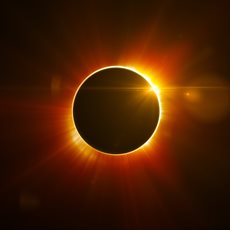Protecting Eye Health During a Solar Eclipse
 A solar eclipse happens when the moon passes between the Earth and the sun, casting a shadow, and totally or partially obscuring the view of the sun. During a total eclipse, the face of the sun is completely blocked by the moon creating an atmosphere similar to dawn or dusk. On April 8, a total eclipse will be viewable in certain areas of the United States along a narrow band stretching from Texas to Maine, including parts of Ohio. A partial eclipse will be visible throughout all 48 contiguous states. Whether it is a partial or total eclipse, the phenomenon creates a unique viewing experience; however, it is important to consider eye health and take proper precautions while watching this extraordinary celestial event.
A solar eclipse happens when the moon passes between the Earth and the sun, casting a shadow, and totally or partially obscuring the view of the sun. During a total eclipse, the face of the sun is completely blocked by the moon creating an atmosphere similar to dawn or dusk. On April 8, a total eclipse will be viewable in certain areas of the United States along a narrow band stretching from Texas to Maine, including parts of Ohio. A partial eclipse will be visible throughout all 48 contiguous states. Whether it is a partial or total eclipse, the phenomenon creates a unique viewing experience; however, it is important to consider eye health and take proper precautions while watching this extraordinary celestial event.
Exposing the eyes to sunlight for too long can cause damage to the retina, the light-sensitive layer of tissue at the back of the eye, and result in a condition called solar retinopathy. Harm to the eyes from the sun occurs with no pain, and symptoms may not appear for a few hours or even a few days. Symptoms include loss of central vision, distorted vision, and altered color vision. Solar retinopathy cases tend to increase when a solar eclipse occurs. Vision usually recovers completely without treatment; however, some people experience permanent vision loss.
Proper safety equipment or techniques are necessary to protect the eyes when viewing the eclipse. Solar eclipse glasses are an effective means to watch the event. To avoid harm to the eyes, the glasses should be purchased from a trusted source, meet safety requirements, be manufactured with ISO 12312-2 filters, and worn at all times when viewing the eclipse.
Pinhole projection is a safe and inexpensive technique that can be used to view an eclipse. Those using this option, view a projected image of the eclipse rather than looking directly at the sun. To make a pinhole projector, two sheets of paper are used. A small hole is punched through the center of the first sheet and is held above the shoulder as the person stands with their back to the sun. The light from the sun shines through the hole, creating an image of the eclipse on the second sheet positioned approximately three feet away.
Other alternatives for safely viewing the eclipse, include number 14 welder’s glass and mylar filters. The eclipse may also be available to watch on television or at a planetarium. With any method, it is important to ensure that all equipment is in good repair. Eclipse glasses, welder’s glass, and mylar filters should be free of scratches. Those without proper equipment should never look directly at the sun. Sunglasses, smartphones, camera lenses, and binoculars do not provide effective protection from harmful sun rays.
Much of Ohio will experience a partial eclipse, including Licking County. In Newark, the eclipse will begin around 1:56 p.m., and will reach maximum coverage of 99 percent at about 3:13 p.m. Several cities in Ohio will experience a total eclipse including, Dayton, Toledo, Cleveland, Delaware, Dublin, and Mount Vernon. Total solar eclipses are a rare occurrence. The last total eclipse visible in Ohio happened in 1806. After this year, the next total eclipse will not occur until 2099. For a full list of areas that are in the total eclipse path on April 8, visit eclipse.test.ohio.gov/where-to-view.html.
| Posted On : 4/3/2024 12:06:19 PM